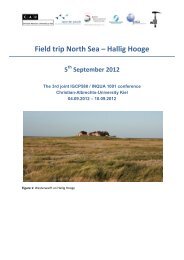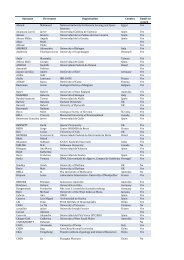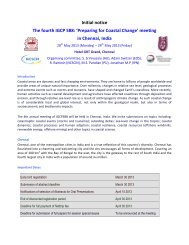Conference program and abstracts - Coastal-Change.Org
Conference program and abstracts - Coastal-Change.Org
Conference program and abstracts - Coastal-Change.Org
Create successful ePaper yourself
Turn your PDF publications into a flip-book with our unique Google optimized e-Paper software.
Benthic Foraminifera <strong>and</strong> siltation studies along the<br />
Depositional Environment between M<strong>and</strong>apam <strong>and</strong><br />
Kodiyakkarai, Palk Strait, East Coast of India<br />
M.Suresh G<strong>and</strong>hi <strong>and</strong> K. Kasilingam<br />
Department of Geology, University of Madras, Chennai- 600 025<br />
Email: surgan@yahoo.co.uk<br />
ABSTRACT<br />
Palk Strait is situated between India <strong>and</strong> Srilanka endangered with heavy<br />
siltation. It is strategically an important channel, as it is shared by India<br />
<strong>and</strong> Sri Lanka without the scope of international navigation. Of late, the<br />
coastal ecosystem of the strait is endangered by the shallowing nature of<br />
the bay due to silty sedimentation. In order to know the effect of siltation<br />
an attempt has been made in this region using foraminiferal studies. A<br />
total of 72 sediment samples have been collected in nine stations<br />
between M<strong>and</strong>apam <strong>and</strong> Vedaranyam. In that, 122 species belonging to<br />
54genera, 40 families, 24 super families <strong>and</strong> 5 suborders were identified.<br />
Of which, 38 species are provided as living specimens. Among the<br />
species present, Ammonia beccarii, Ammonia dentata, Osangularia<br />
venusta, Elphidium crispum, Asterorotalia trispinosa, Quinqueloqulina<br />
seminulam, Pararotalia nipponica exhibit prolific abundance. From the<br />
distribution of foraminiferal studies, it understood that the species are<br />
more enriched in southern part of Palk Strait compare to the northern<br />
part. The organic carbon content in the study area varies from 0.05 % to<br />
3.40 %. At Kodiyakkarai carbonate content reaches 19.5% at 7m depth.<br />
The higher carbonate content at Thondi <strong>and</strong> Kottaipattinam is probably<br />
due to the accumulation of high order broken shell debris dumped<br />
through the creek. Based upon the living dead ratio <strong>and</strong> the organic<br />
matter distribution it is confirmed that the southern part is more favor for<br />
living condition. Sedimentation also more in the southern part between<br />
M<strong>and</strong>apam <strong>and</strong> Manalmelkudi compare to the northern part. Cluster<br />
analysis indicates that three different genus dominant in particular stations<br />
like M<strong>and</strong>apam <strong>and</strong> Thondi represent the biotope at 0.82 level of<br />
clustering <strong>and</strong> the species Rosalina globularis is more abundant in that<br />
stations. Attankarai <strong>and</strong> Manalmelkudi show the level of clustering of 0.87<br />
with dominant of Ammonia beccarii. The stations Devipattinam,<br />
Kottaipattinam <strong>and</strong> Sethubavachattiram shows the level of clustering at<br />
0.9 <strong>and</strong> dominant of Pararotalia.Some genera like Asterorotalia, Lagena,<br />
Elphidium, Quinqueloqulina, Pararotalia <strong>and</strong> Spiroloculina are in broken,<br />
distorted <strong>and</strong> corroded are noticed in all the stations. The high order of<br />
broken species <strong>and</strong> aberration in forams is stations like M<strong>and</strong>apam,<br />
Devipattinam, Thondi <strong>and</strong> Sethubavachattiram indicate the presence of<br />
higher churning action of currents. The overall depletion of foraminifera in<br />
the strait indicates the unfavorable environmental conditions for living<br />
species.<br />
The Fourth IGCP 588: PREPARING FOR COASTAL CHANGE 19





